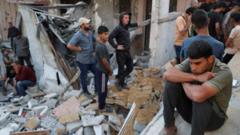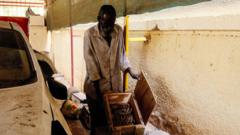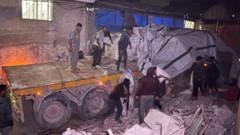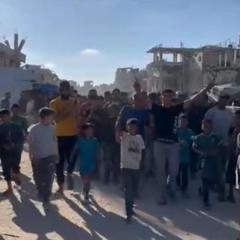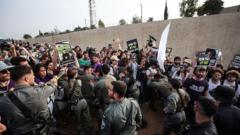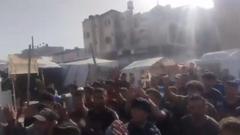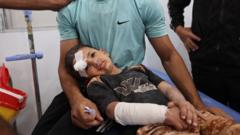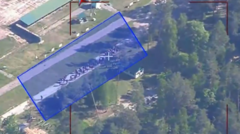Chaos erupts as residents struggle for essential supplies following a partial lifting of the Israeli blockade.
**Desperation Intensifies as Food Crisis Escalates in Gaza**
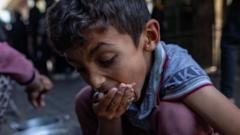
**Desperation Intensifies as Food Crisis Escalates in Gaza**
The humanitarian situation in Gaza deteriorates amid violence and food shortages.
As limited food supplies tentatively enter Gaza after a brief easing of the Israeli blockade, scenes of desperation have emerged, revealing the harrowing humanitarian crisis gripping the region. A partial lifting allowed a mere trickle of aid to come through, but it wasn’t enough to quell the rising tide of hunger.
Bakeries in Gaza have found themselves overwhelmed by desperate crowds, resulting in forced closures on Thursday. In a disturbing turn of events, armed looters attacked an aid convoy, prompting a firefight with Hamas security personnel. Eyewitnesses report that the chaos escalated further when Israeli drone strikes targeted Hamas officials protecting humanitarian efforts.
The convoy, comprised of 20 trucks coordinated by the World Food Programme (WFP), was delivering vital supplies when assailants attempted to seize the cargo. Hamas officials engaged in a firefight with the attackers, but the ensuing Israeli drone response devastated their ranks, killing several security officers.
The scant aid recently permitted into Gaza, accounting for approximately 130 trucks over three days, still falls drastically short of the 500 to 600 trucks needed daily according to the United Nations. Meanwhile, international organizations, including the WFP, have voiced concern that increasing violence obstructs the delivery of crucial food and medical resources to the population—a majority of whom are displaced.
Israeli authorities assert that the blockade aims to pressure Hamas to release hostages, while also accusing the group of stealing supplies, which Hamas denies. The WFP reported that their aid trucks were vandalized overnight, highlighting the urgent need to ensure safe passage for humanitarian delivery.
As the situation escalates, many Gazans express anger and frustration with the designated aid distribution methods. Criticism has been levelled against the WFP, with advocates calling for a more effective approach—suggesting that distributing flour directly would empower families to bake for themselves, rather than risking their safety in crowded distribution centers.
Reports from evacuees describe a grim reality where basic services have collapsed amidst ongoing conflict. A father of two struggling in a southern Gaza camp conveyed the crushing lack of food, water, and medicine, stating, “The repeated air strikes add to the suffering.”
Faced with an inadequate supply of resources, humanitarian agencies warn that the reality on the ground remains dire. Despite pledges of aid, UN Secretary General Antonio Guterres highlighted the disparity between the number of trucks cleared for entry and those that have actually delivered supplies. The humanitarian situation teeters on the edge of disaster, with famine looming ever closer over Gaza’s overwhelmed populace.
With health centers reporting malnutrition among mothers and children, residents and aid workers alike continue to voice their urgent plea for immediate and substantial assistance. As dangerous conditions persist, many families cling to a sliver of hope for the vital resources that remain fearfully out of reach.
Bakeries in Gaza have found themselves overwhelmed by desperate crowds, resulting in forced closures on Thursday. In a disturbing turn of events, armed looters attacked an aid convoy, prompting a firefight with Hamas security personnel. Eyewitnesses report that the chaos escalated further when Israeli drone strikes targeted Hamas officials protecting humanitarian efforts.
The convoy, comprised of 20 trucks coordinated by the World Food Programme (WFP), was delivering vital supplies when assailants attempted to seize the cargo. Hamas officials engaged in a firefight with the attackers, but the ensuing Israeli drone response devastated their ranks, killing several security officers.
The scant aid recently permitted into Gaza, accounting for approximately 130 trucks over three days, still falls drastically short of the 500 to 600 trucks needed daily according to the United Nations. Meanwhile, international organizations, including the WFP, have voiced concern that increasing violence obstructs the delivery of crucial food and medical resources to the population—a majority of whom are displaced.
Israeli authorities assert that the blockade aims to pressure Hamas to release hostages, while also accusing the group of stealing supplies, which Hamas denies. The WFP reported that their aid trucks were vandalized overnight, highlighting the urgent need to ensure safe passage for humanitarian delivery.
As the situation escalates, many Gazans express anger and frustration with the designated aid distribution methods. Criticism has been levelled against the WFP, with advocates calling for a more effective approach—suggesting that distributing flour directly would empower families to bake for themselves, rather than risking their safety in crowded distribution centers.
Reports from evacuees describe a grim reality where basic services have collapsed amidst ongoing conflict. A father of two struggling in a southern Gaza camp conveyed the crushing lack of food, water, and medicine, stating, “The repeated air strikes add to the suffering.”
Faced with an inadequate supply of resources, humanitarian agencies warn that the reality on the ground remains dire. Despite pledges of aid, UN Secretary General Antonio Guterres highlighted the disparity between the number of trucks cleared for entry and those that have actually delivered supplies. The humanitarian situation teeters on the edge of disaster, with famine looming ever closer over Gaza’s overwhelmed populace.
With health centers reporting malnutrition among mothers and children, residents and aid workers alike continue to voice their urgent plea for immediate and substantial assistance. As dangerous conditions persist, many families cling to a sliver of hope for the vital resources that remain fearfully out of reach.


